| INTERVIEW WITH RICK SLOANE
|
|
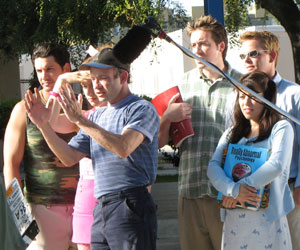 | Rick Sloane is known best for his film "Hobgoblins," after it appeared on Mystery Science Theater 3000. He also wrote, directed, and produced the Vice Academy series. Still, "Hobgoblins," with its furry little monsters, is Mr. Sloane's most famous film and currently on his mind, because he is releasing "Hobgoblins 2" in 2008.
I had the good fortune to interview the gentleman and he provided some great peeks into his films, everything from being a little frustrated with padding the running time for the distributors to the humor involved in casting porn queen Ginger Lynn in "Vice Academy" and her not removing any clothing. There are also some sneak peeks at "Hobgoblins 2" for b-movie fans.
Interview Date: 2 February 2008
|
|
| Andrew:
| What is your background, such as childhood, schools, and interests - especially film? When did you start shooting movies?
|
| Rick Sloane:
| I grew up in Los Angeles; I even attended Hollywood High School. As a child, the first thing I was ever told I was good at was story telling. Every school year, the teachers would ask us to stand in front of the class and tell what we did over the summer. Every single year, each teacher would announce that I did the best job, and call me back to the front of the class to tell my story a second time. I think the ability to tell a story is what drew me towards film making. By the time I was eight or nine, I was already aware that my classmates would expect my story to be the best. I'd put a spin in it, making it more exaggerated in certain areas, so it always got a laugh. I already had my first captive audience.
I think I'm one of the few low-budget exploitation film makers who actually attended film school, though it was only Los Angeles City College, not one of the major universities. Everyone else started out as a production assistant on someone else's film. I never was on a film set until I started directing my first feature.
In film school, I was quickly singled out by a couple of instructors who considered me the least talented student in the bunch; whatever I did was always ridiculed. I never had the pretention the other students did, they all assumed they would go on to make art festival movies that would win awards. It wasn't where my heart was at.
I always wanted to make the exact kind of films that I enjoyed watching as a teenager. My directing teacher dropped me from his class on the very first day. He said he needed to weed out people who didn't belong in filmmaking. It was tough on my ego, but I had already seen one of the features he had made, and wasn't impressed at all. I waited a year until someone else taught the same class.
The gears in my head were thinking about making my first feature after I watched "Hollywood Boulevard" when I was eighteen. It's the most influential film of my career. Every director has one. John Waters was inspired by "Faster Pussycast! Kill! Kill!" and this was my inspiration.
Hollywood Boulevard was shown at school as a joke. Everyone hated it, except I sat there in awe, knowing this was the kind of film I wanted to make. I quickly wrote my first feature, Blood Theatre, which I started shooting when I was twenty-one. I loved Mary Woronov, who was the villain in Hollywood Boulevard, and I approached her to be in it. I never expected she would accept the role; this was right when Eating Raoul was still playing in theatres. We met for lunch, at Schwab's in Hollywood, which I thought was such an "industry" place to meet then. I was completely floored when she agreed to do it.
Blood Theatre took almost a year to complete; actors kept dropping out of the project and had to be replaced, causing certain scenes to be reshot repeatedly. I managed to assemble the film and screened it for everyone at school. It was met with a dead silence; everyone said I should cut it to ten minutes long. By then, I had long stopped listening to their opinions. It was just a good place to have free access to a soundstage, lighting and editing equipment. I completed it as a feature, got it picked up by a distributor and was actually asked back to speak at the school, the very one where I was dropped from because "I didn't belong in film making." I spoke there once, never looked back, and had three features out by the time I was twenty-five.
| |
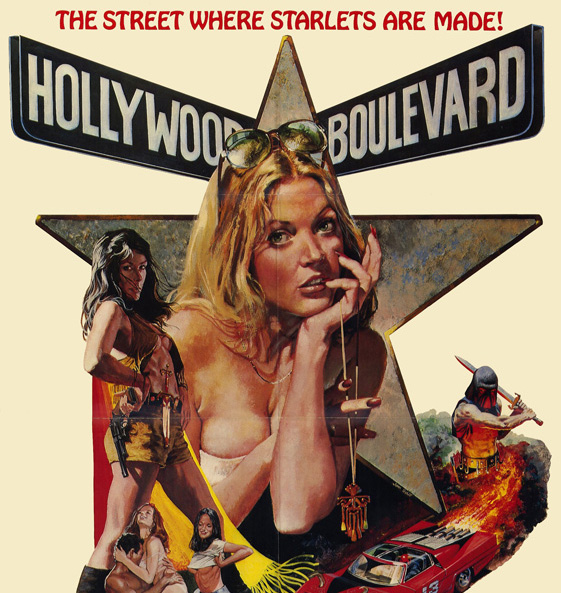 | "I watched 'Hollywood Boulevard' when I was eighteen. It's the most influential film of my career. Every director has one. John Waters was inspired by 'Faster Pussycast! Kill! Kill!' and this was my inspiration."
|
|
| Andrew:
| Since it seems that film school was, for you, all about having easy access to the tools of the trade, and not the quality of the instruction, what kind of advice would you give to someone who wants to make movies?
|
| Rick Sloane:
| If you want to make movies, go out there and do it. It's like wanting to be an actor - you need to pursue it while you're young. Some people would rather work their way up the ladder over a number of decades, I say, just go out and make your own movie now.
Pick a low-budget film you really like, and watch it repeatedly, I mean at least twenty times or more. Count how many locations are in the film, then try to guess which parts of the film were all shot on the same day. Then get a feel for how many camera set-ups they used for each scene. These are all necessary to learn the craft.
Write a story around locations you have access to, or shoot most of it in your garage. Borrow film school equipment. Get people to work for free by promising them a feature film credit. And when any crew members complain about the cheap food, replace those people. They obviously have more interest in becoming food critics than film makers anyway.
Movies like "Bowfinger" and "Ed Wood" are hilarious when they show how far people will stoop to make a film. There's nothing in those two films that I haven't already done in one movie or another, except for wearing angora.
| |
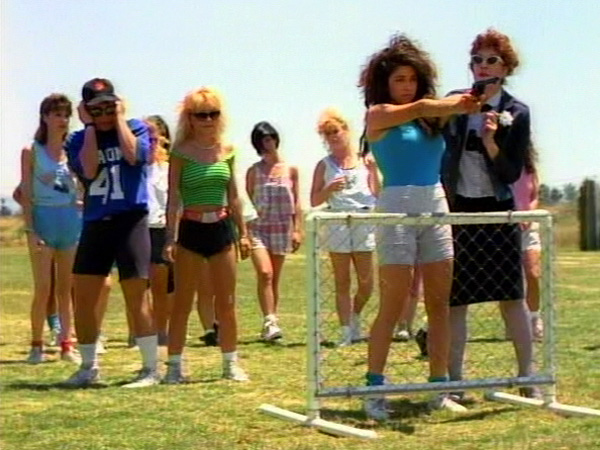 | "Write a story around locations you have access to..."
|
|
| Andrew:
| You write, produce, and direct your films. Doing so gives you a lot of control over the finished product, but are there any specific reasons you have made that a standard rule?
|
| Rick Sloane:
| I'm definitely a control freak, anyone who wears this many hats has to be. There's a film school word for it, "auteur," which I always cringe when I hear. It's just not a word that applies to low-budget film making. I do all the pre-production work, find all the costumes and props and create the look of each film for almost nothing. I also do all the post-production, down to adding every sound effect and cutting the negative.
Even with the small budgets I've had to work with, I've had to sit through distributor meetings and listen to all the changes they want. One of the most annoying things that got slapped into almost every contract I signed was a minimum running time requirement of 88 minutes. None of the other low-budget film makers I knew ever had this rule placed on them. Distributors would ask me to stretch my films five or ten minutes longer, no matter how padded it made them. One example is the embarrassing garden tool fight in the first Hobgoblins. It was only a thirty second scene where Kevin is knocked down once and loses. I was asked to take all the footage I shot and make the scene longer. That's why the scene is so ridiculous. The character Nick was never in the original script, they asked for me to add an army guy.
The only other film I made that was so seriously tampered with was "Marked for Murder." It's hard to believe, but it started out as a film about a teenager who sees a UFO, then is pursued by government agents. Ten rewrites later, it was about a lost shipment of heroin. I have to give Trimark (now it's Lionsgate) credit for the changes in that one; it became the highest grossing film I ever made. Leonard Maltin even gave it a good review. Of course, it's my only film today that isn't available on DVD. But since I've become famous for my early "bad" films, I guess it keeps the folklore going that you can't see my only "three out of four stars" rated movie. It was licensed in a package to television in the 90s. "Marked for Murder" used to run on ABC late night; I was very proud.
| |
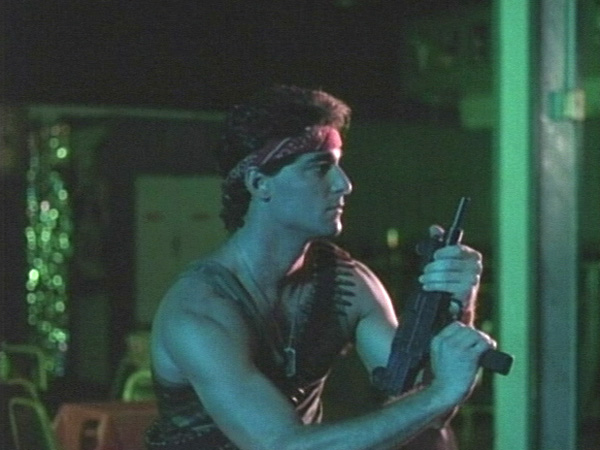 | "The character Nick was never in the original script, they asked for me to add an army guy."
|
|
| Andrew:
| What sort of budgets are you usually working with and do you ever put your own "money on the line" when you make a film?
|
| Rick Sloane:
| I don't think I've ever divulged how low my budgets really are. I still shoot on 35mm and bring my features in on lower budgets than people spend on digital video. My record is that I got "Visitants" in the can for $8500. Not a typo, that film was shot for less than nine thousand dollars. Post-production obviously more than doubled it, since I had a film print on that one title, but it is the least I've ever spent on a film. If you add the budgets of all fourteen of my features together, it's still way under a million dollars total.
Since I retain ownership on all my films, I have had to put my own money into them. The risks were minimal on any of the Vice sequels; they were all pre-sold to cable before they were even written. Film makers are very lucky if they ever have a feature that becomes a franchise, with "Hobgoblins 2" coming out in 2008, I was fortunate to have two franchise titles.
| |
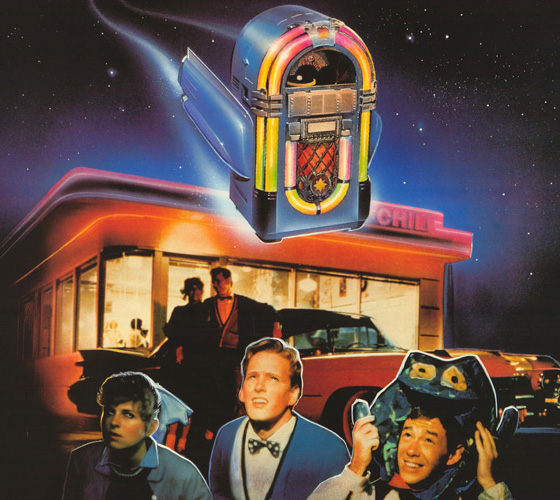 | "My record is that I got "Visitants" in the can for $8500. Not a typo, that film was shot for less than nine thousand dollars."
|
|
| Andrew:
| What was your difficult film? Meaning, which one required the most work and frustration to bring it from idea to actual movie?
|
| Rick Sloane:
| In terms of the most work, I'd have to say "Hobgoblins 2." I hadn't made a feature in eight years, and it took a lot to step back to the plate and make my return. I had a number of scripts rejected one after another, and after making six Vice Academy films, it was like I became a one trick pony. I never would have expected "Hobgoblins" to become a series either, but Mystery Science Theater 3000 made the film so popular, that I decided to take a turn at Part 2.
It was the most time I ever spent on a single script. After an eight year absence, I didn't want to make a comeback with a quick knock-off. The "Vice Academy" films were shot very close together, Parts 2 & 3 were both made the same year, and the scripts had to be cranked out quickly. That was back when they aired on USA Network; they were pre-sold before I ever shot them and had air dates slapped on them before they were even scripts. That translated to quick scripts with no time for rewrites.
"Hobgoblins 2" went through five totally different rewrites. Not sure if I remember the exact order, there was a horror version, a comedy, a remake, a really low-budget one that would be the easiest to shoot, a bigger budget one, with a lot of actors in a period mental hospital, then a composite of all of them together. I wound up shooting the most difficult one, which I chose on purpose. I wanted the film to look big. I'm bothered by so many of the current crop of low-budget features that are all shot on digital video. No matter how you light them, they wind up looking somewhere between porno and a soap opera. I wanted "Hobgoblins 2" to look like the original, so I decided to shoot on 35mm, even though hardly anyone does these days for direct to DVD.
| |
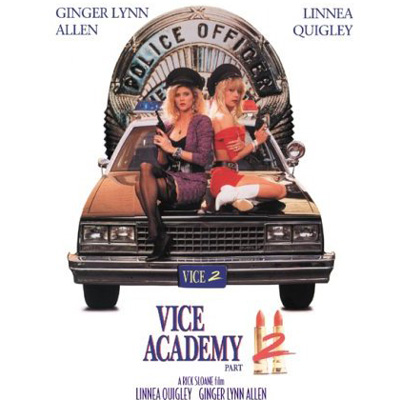 | "The 'Vice Academy' films were shot very close together, Parts 2 & 3 were both made the same year, and the scripts had to be cranked out quickly. That was back when they aired on USA Network; they were pre-sold before I ever shot them, and had air dates slapped on them before they were even scripts."
|
|
| Andrew:
| Looking at your credits, most of your films are geared for female nudity and comedy, like the six "Vice Academy" films. Those are quite different from "Hobgoblins" and "The Visitants." Do you have a personal preference in either kind, and, if so, why the other genre?
|
| Rick Sloane:
| There's so little nudity in my films, if you took all the scenes from all my movies combined, I think it would only run a few minutes total. All the Vice Academy films aired on basic cable, where there was no nudity. I think everyone assumed they were heavily edited, but if you saw the complete film, there was only about fifteen seconds of nudity removed. I only put it in for the foreign release, where they demand two topless shots in each film. I think because Ginger Lynn is in the first three Vice films, everyone expects them to be porn, which they're far from being. I do recreate the look of a porn film in the make-up, hair and storyline, so they have a deliberately seedy look to them, but they're much closer to "Married With Children" in style, than to adult films.
"The Visitants" is one of my personal favorite films. I was always surprised that MST3K passed on it, but wanted "Hobgoblins." I would have guessed the other way around, but it's hard to overlook such a terrible puppet movie. They said "Visitants" was too intentionally campy; so was "Hobgoblins," just no one noticed.
One of running themes in my films is that there is usually a period look to them. "Blood Theatre" opens in the 1930s, "Visitants" opens in the 1950s, "Hobgoblins" has a flashback to the 1950s, and in "Vice Academy," the school hasn't had funding since the early sixties and everything there is outdated. When it's time for graduation, they still drag out their old 78 rpm phonograph for the commencement music.
In terms of picking a favorite genre, I'd choose campy period films like "Visitants" and "Hobgoblins." I've always had a fondness for the 1950s and early 60s; that's the time period I do the most often. In "Hobgoblins 2," the mental hospital is frozen in the early 60s. It was the last era where they still did lobotomies and shock treatment, and I felt it added more to the horror elements of the plot.
| |
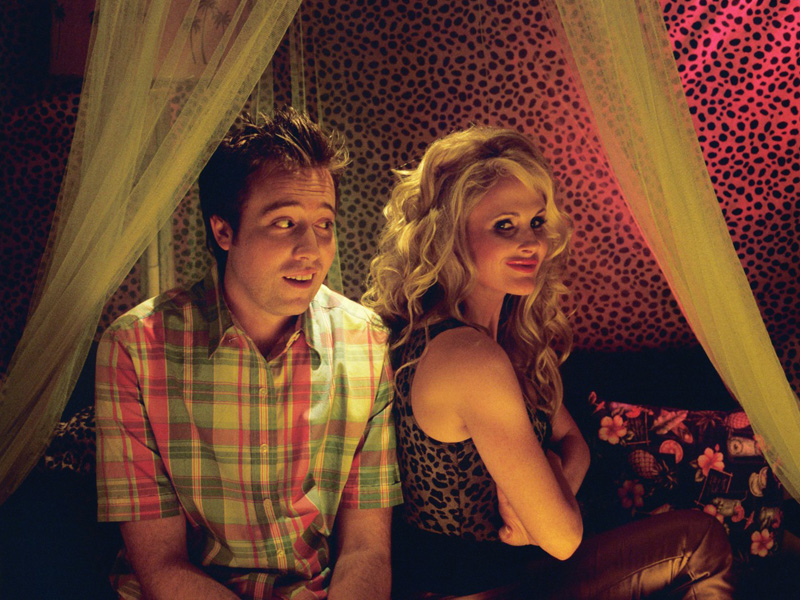 | Kyle is still in love with Fantasia after all these years.
"I set out to make my films look like 'Married With Children.' No one gets naked, but it's still racy and trashy."
|
|
| Andrew:
| That is interesting, that a film titled "Vice Academy" and featuring Ginger Lynn would lack nudity. I think that my viewing of it was on basic cable and I had always assumed there was nudity in the actual release. Is there any reason behind that? Do you consider it overdone or a lazy way to pad a movie?
|
| Rick Sloane:
| I've never considered nudity a way to pad a film. Fans of low-budget films can never get enough nudity. I set out to make my films look like "Married With Children." No one gets naked, but it's still racy and trashy. Soft core is a completely different genre. It's difficult to try and tell a story when you have to stop every ten minutes for the characters to have sex.
Hiring a porn queen like Ginger Lynn, then having her keep her clothes on, was part of the joke for me. You can watch a hundred movies where she has sex in them. She stays clothed in mine, but the story line manages to have her degraded more than in her adult work. USA Network picked up on the joke, when they would break the film between commercials, their tag was, "Watch Ginger Lynn keep her clothes on." It's a curiosity factor, like when an actor who never sings, suddenly takes a musical role in a film. People want to see them out of the comfort zone, and for Ginger, that's staying on her feet and using her mouth for speaking.
| |
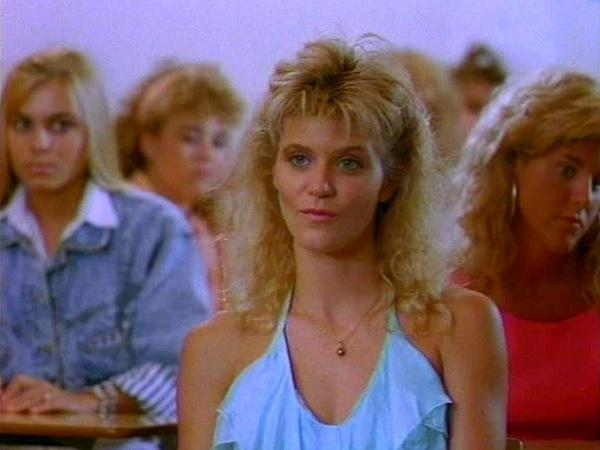 | "Hiring a porn queen like Ginger Lynn, then having her keep her clothes on, was part of the joke for me."
|
|
| Andrew:
| Out of the actors and actresses who have appeared in your films, which do you remember the best and why?
|
| Rick Sloane:
| Most excited to work with would be Mary Woronov, since I loved her in Hollywood Boulevard and Rock n Roll High School. It was a thrill to have one of my idols in my first feature. I also loved "The Brady Bunch" as a child, and was thrilled to work to get Christopher Knight in "Good Girl's Don't." He is Peter Brady in person; it was so difficult for me to separate him from his TV persona. He's also one of the nicest guys I've ever met, was great to see him return to the limelight in "The Surreal Life" and "My Fair Brady."
Most intimidating to work with would be a tie between Martin Sheen and Wings Hauser. They were both in "Marked For Murder," and I was still early in my career and not prepared for either of them. They were both good sports. I just wasn't ready to offer either one any direction. I just let them do what they wanted, which in hindsight was definitely the correct choice. I couldn't improve on their acting today and glad I didn't try when I was still in my twenties.
Biggest slap in my face would be both Ginger Lynn and Linnea Quigley. After working with Wings Hauser and Martin Sheen, the last thing I needed was to have the two of them pull diva attitudes on me. Linnea's agent insulted me to my face when she turned "Vice Academy 3" down for Linnea, though in the long run, she did me a favor. Ginger was much sadder, we were actually good friends during Vice Academy 1 & 2, but by Part 3 she was dealing with drug addiction, and turned on me. I paid her one of the highest paychecks of her life, and even gave her a cash advance out of my own pocket when she asked for help on her legal bills. In return, she was three hours late every day and would never memorize her dialogue. She threw the film overbudget and overschedule, then had the audacity to call me the worst director she ever worked for in interviews. Guess some people don't mind burning their bridges.
| |
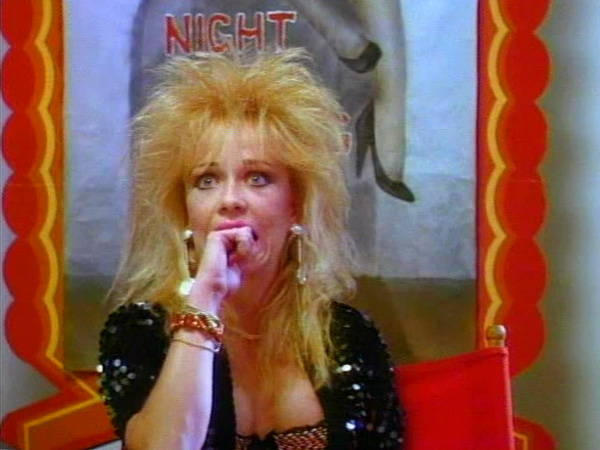 | "After working with Wings Hauser and Martin Sheen, the last thing I needed was to have the two of them pull diva attitudes on me."
|
|
| Andrew:
| "Hobgoblins" is probably the most famous of your movies, due to it appearing on Mystery Science Theater 3000. How did that come about?
|
| Rick Sloane:
| The Vice Academy films aired on USA Network, and they also owned the Sci-Fi Channel. They had Mystery Science Theater 3000 screen the Vice films after Up All Night would not be renewed. This was the first year that Mystery Science Theater 3000 moved to the Sci-Fi Channel. They passed on the Vice titles, but asked what else I had. The story somehow got around that I personally submitted Hobgoblins to them. It's partly true, but only because of the USA Network connection. That story is so widely known today, much like the one that I reused the costumes from the first Hobgoblins in the sequel. Only one costume was kept that long then reused, but the actress who wore it wanted to keep it. When I told her it was from the first film, she posted online that all the costumes were from the first film, which they weren't. I hate spoiling everyone's fun that I didn't reuse the same costumes, but finding an identical pair of hot pink shorts for Kyle to wear took forever to find.
| |
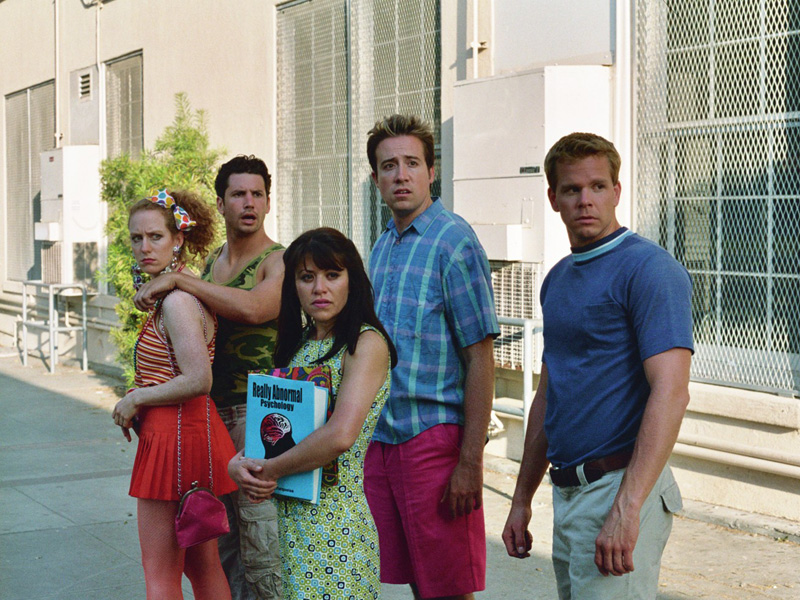 | Daphne, Nick, Amy Kyle and Kevin, outside of the mental hospital where McCreedy has been locked away.
"...finding an identical pair of hot pink shorts for Kyle to wear took forever to find."
|
|
| Andrew:
| I polled the site's regular readers about any questions they would like to ask you and here is one from CheezeFlix (his online nickname): How do you feel about MST3K's treatment of your film, "Hobgoblins?"
|
| Rick Sloane:
| I get asked that very same MST3K question a lot. My entire career has been making films that are spoofed while they are airing on television. USA Network's "Up All Night" ran all the Vice Academy films, with Rhonda Shear and Gilbert Gottfried acting as the show's hosts, and making jokes at the film's expense between commercials. I learned a lot about the pacing of my films, by watching what footage that would be edited out and where they would interrupt them. By the time I made the first sequel, I was fully aware they would be breaking into each film and adding their own jokes. I made the films more interactive starting with Vice Academy 2, made it easier for them to parody.
Hobgoblins was another story; that movie was made very early in my career. It was never one of my favorite films. I laughed through the entire MST3K episode, until the very end. I wasn't expecting the humor to suddenly be at my own expense. I was mortified when they dragged out the cardboard cutout and pretended to do an interview with me. I was caught off guard. I had never seen them rip apart any other director before on the show.
But in the long run, that was what made the movie famous. There would have never been a Hobgoblins 2 without MST3K and I hope one of their incarnations decides to riff on the sequel. It won't be the same without it. As I was editing Hobgoblins 2, I could almost guess some of the jokes they would insert. I even named the production company, Halfway 2 Sanity, which I'm sure will not go unnoticed.
| |
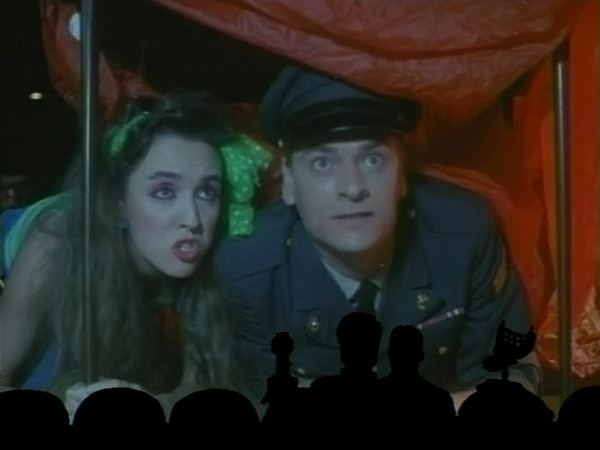 | "I laughed through the entire MST3K episode, until the very end. I wasn't expecting the humor to suddenly be at my own expense. I was mortified when they dragged out the cardboard cutout and pretended to do an interview with me. I was caught off guard. I had never seen them rip apart any other director before on the show."
Listen to the fake MST3K interview with Servo asking questions and Crow pretending to be Rick.
|
|
| Andrew:
| You said that "Hobgoblins 2" was just completed. Is it a continuation from the first movie, with some characters returning, or does a different group encounter the monsters?
|
| Rick Sloane:
| The story picks up twenty years later, the same amount of time since the last film. Most sequels don't wait twenty year to happen, but like in Psycho 2, the protaganist has been in a mental hospital for twenty years, then the same problems return.
I did have to recast everyone, but in the same way they find look-alike actors when they do feature versions of old TV shows; I sought out actors who looked like the original cast. I dressed everyone like it was still 1987, and followed all the rules of sequel film making. There actually are actual rules to sequel film making; maybe everyone thinks I'm joking. USA Network explained them to me every time I did another sequel. "You need to bring the same characters back and follow the same story lines you established. A good example of a sequel is Halloween 2; it picks up where the first film ends. A bad example of a sequel is Halloween 3; it has nothing to do with the first two films, and bombed at the box office." And very few films have a Part 2 without planning a Part 3, but we'll worry about that later.
Hobgoblins 2 is painstakingly close to the original. I know fans have seen the first film repeatedly. There's a list of every possible error on IMDb, and you don't catch those when you see a film only once. I also read several message boards to see what everyone was writing about. The two most common threads were the garden tool fight and how cheap the puppets looked. Both are prominent in the sequel. I had a great laugh the first day of filming when one of the new actors asked if the creatures were going to be done with CGI. I don't think any of them expected to be rolling on the ground with the same puppets from the first film. Those poor puppets suffered a lot of injuries during the sequel. Latex wasn't built to last twenty years, and be repeatedly rolled over and thrown on the ground. I think every puppet needed to have its limbs sewn back on before the movie wrapped.
| |
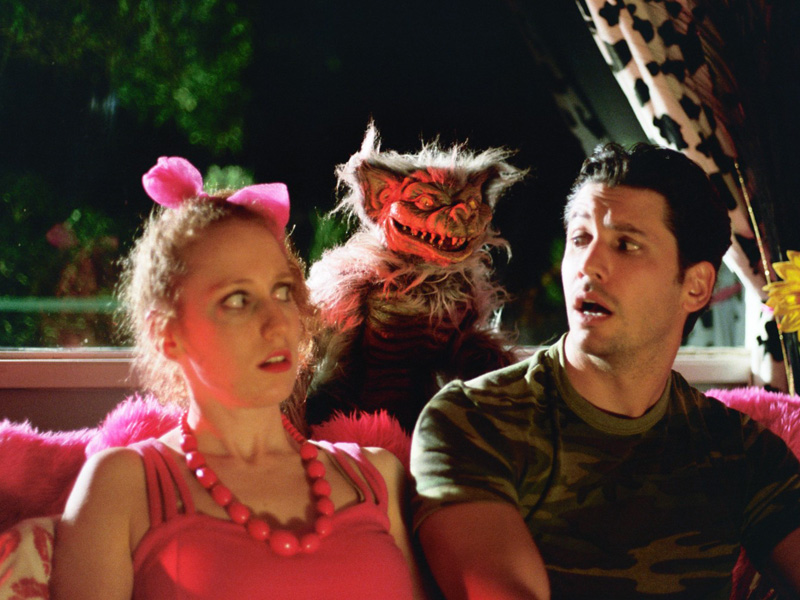 | Daphne and Nick are revisited by one of the Hobgobglins.
"I had a great laugh the first day of filming when one of the new actors asked if the creatures were going to be done with CGI. I don't think any of them expected to be rolling on the ground with the same puppets from the first film."
|
|
| Andrew:
| The original "Hobgoblins" puppets are returning in the sequel? That is amazing. Where have they been for the last twenty years? Also, attached to that thought, who made them in the first place?
|
| Rick Sloane:
| I come from a family of pack rats. No one in my family ever throws anything away. I still have all my childhood toys. I had never planned on a sequel to "Hobgoblins." The film quietly disappeared from video and was long forgotten. After Mystery Science Theater 3000 aired the film, twelve years after it was made, it suddenly found new fame. I watched as it climbed the Internet Movie Database list of worst films of all time. At its peak, it came in second only to Gigli.
The puppets have been sitting quietly on a very high shelf for the last twenty years. I had expected the latex to deteriorate, and was I surprised to see that they held up better than I expected. They were built by Ken Hall, who also worked on "Ghoulies." He didn't deliver the puppets until the night before we started filming. It wasn't until then that I realized they were unable to move, but he said that was all I got for what he charged. I would have kicked in a few hundred more to at least have them blink. The cheapness of the puppets is possibly what made the film so popular, so maybe it was meant to be. I briefly debated having one better puppet made for Part 2 that could actually walk and blink, but decided to leave the effects alone and make the film faithful to the first one.
| |
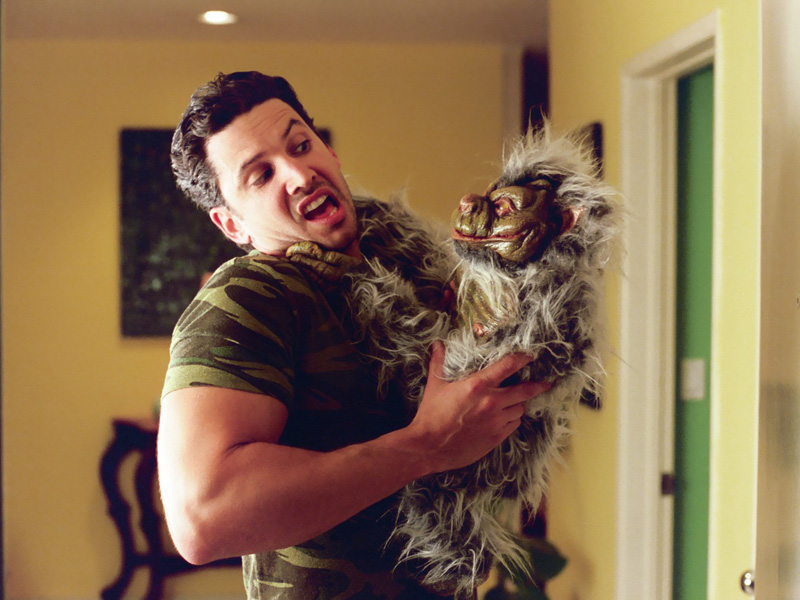 | Nick struggles with one of the creatures that has found its way into the house.
"I briefly debated having one better puppet made for Part 2 that could actually walk and blink, but decided to leave the effects alone and make the film faithful to the first one."
|
|
| Andrew:
| What are the release plans for "Hobgoblins 2?"
|
| Rick Sloane:
| It will be released in mid-2008. I'll probably do the horror convention circuit to see what kind of interest the sequel generates . If it does anywhere near as well as the first film, let's just say I already have the script for Part 3.
| |
| Andrew:
| Are there any projects you would like to work on? Any scripts you wrote that have not made it past that stage?
|
| Rick Sloane:
| I have another film in production for 2008. I don't want to divulge the title yet, I've had them stolen from me in the past, and this is a really clever one. It's similar in theme to "Re-Animator" from the 80s, which they're also doing a remake of for 2008. I'm not going to pretend that the timing is a coincidence. When you work in low-budget, the first question distributors ask is "what is the closest film it's like," and they mean something recent.
I have so many scripts I've written that were never made. I had one five years ago that was very close to being made. It was based on a true story from 1958, my favorite era, about the government accidentally dropping an atomic bomb on a farm in South Carolina, then covering it up. The place is still a tourist attraction today. I'm amazed there's never been a film on what happened there. I wrote the film right before 9/11, and no one wanted a film about a bomb being dropped in America at that time. It also would have been a very difficult film to create on a low budget. There were many effect shots in it.
| |
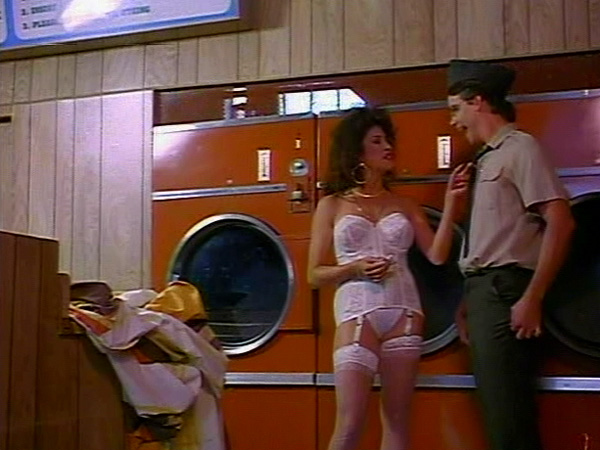 | "When you work in low-budget, the first question distributors ask is 'what is the closest film it's like,' and they mean something recent."
|
|
| Andrew:
| Now, you have been making low-budget movies since the 1980s. You must be dealing with a changed environment - some things for better, some for worse. Technological improvements must be helpful, but what about the pool of talent available?
|
| Rick Sloane:
| I'm from the old school of film making; I still prefer film over digital. "Hobgoblins 2" was the first film I edited on computer, all my earlier features were cut on film. It kills me how today's teenagers can learn Final Cut Pro in a couple of days and edit an entire movie. That system baffles me so much, it actually took me longer to cut on digital that I used to spend on film. It's embarrassing that everyone else knows a program that I can't seem to grasp easily. I will admit sound effect editing on the computer is one hundred times faster than on film, but when it comes to picture editing, I still miss film.
The one recent movie that inspires me so much to keep making films is "Grindhouse." I haven't been so excited by any single film since I was a teenager. It's like the best B-movie ever made. I only wish I were famous enough to have been asked to shoot one of the fake trailers. I actually had that same idea before I even started making features. When I was eighteen, I shot a number of fake exploitation trailers, titles like: "Chainsaw Chicks," "Nightmare of the Lost Whores," and "Amputee Hookers." After I saw "Grindhouse," I dug up my old trailers, had them digitally transferred and they appear during the end credits of "Hobgoblins 2." It's like coming full cycle; my most recent film ends with the first ones I ever made.
I have a lot of critics who call me a bad director, but I don't think people realize that my films look like what I intended to make. I started off making the same films I enjoyed as a teenager, and just never changed my tastes. With digital being so inexpensive, it's much easier for young filmmakers to get started today. I hope "Grindhouse" brings back a renaissance in low-budget exploitation, and I hope I'm not the last one still shooting film.
| |
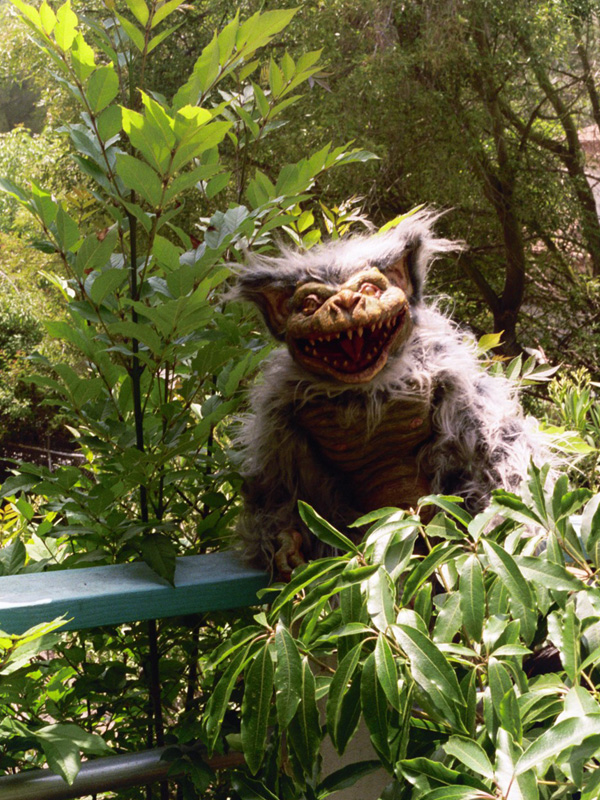 | WE'RE BACK!
|
|
The "Hobgoblins 2" trailer is available on YouTube.
I would like to thank Rick for taking the time to answer the interview questions. He was exceptionally friendly, and having the chance to speak with him about his films, both past and future, was a fun experience. Something that Mr. Sloane touched upon is also a point that crosses my mind when I work on reviews: what is written might not be intended as a personal attack or insult to the person(s) who made a film, but it could easily have that effect. Directors, writers, and cast put a lot of work and energy into these films. Audiences might not always like the end result; sometimes the recipe used works, sometimes it does not. You always have to respect the effort.
For more information on Rick Sloane, please see his IMDb Profile.
|
| |
|
|
|
| Badmovies.org is owned and operated by Andrew Borntreger. All original content is © 1998 - 2014 by its respective author(s). Image, video, and audio files are used in accordance with Fair Use, and are property of the film copyright holders. You may freely link to any page (.html or .php) on this website, but reproduction in any other form must be authorized by the copyright holder. |
|
|
